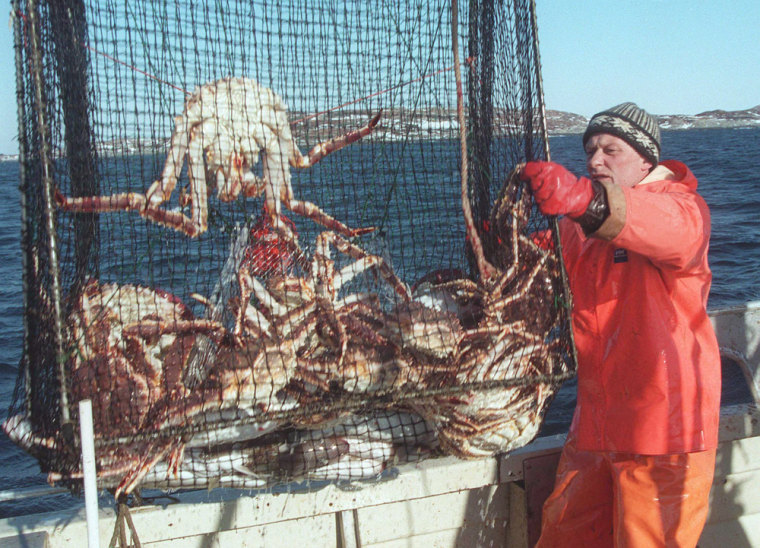Josef Stalin is creating jobs in the Arctic as Norway seeks to halt a “Red Army” of monster crabs that some experts fear could sweep as far south as the Mediterranean.
Hundreds of Norwegian and Russian fishing boats are making big profits from the king crabs but there are fears that tougher measures are needed to stop the invaders, introduced by Moscow from the Pacific Ocean since the 1930s.
“The crabs are generating a lot of money among fishermen, but the introduction of the crabs is a gamble with nature,” said Lars Petter Oie, a Norwegian diver who catches crabs and serves them as a delicacy for tourists near the Russian border.
On a “crab safari” in a fjord surrounded by snow-covered hills, one of Oie’s colleagues plunges into the chill waters from a boat to hunt the crabs, which can grow up to 59 inches from claw-tip to claw-tip.
As nesting kittiwakes squawk from a nearby cliff, he emerges 15 minutes later from the depths with a haul of eight crabs, a mass of flailing giant red arms.
“Keep your fingers away from the claws,” advises Oie. He boils the crabs and serves them with bread and mayonnaise on the edge of the fjord.
About 155 miles to the west of Jarfjordbotn, Norway has drawn a line in the sand off its northernmost Arctic tip to try to halt the advance of the spiny crabs, introduced to the barren Soviet northwest by dictator Stalin to provide food.
West of the line, Norway is allowing a free-for-all to catch the crabs, which cost up to $100 a kilo in Oslo. East of the line, Russian and Norwegian fishermen have a catch limit of 3.3 million crabs for 2006.
Environmentalists say the crabs are an alien species that may decimate other life in the Barents Sea and that Norway should try to exterminate the invaders rather than manage them like cod or herring stocks.
“There is no reason why Norway should accept an alien species introduced by the Russians with unknown and potentially enormous impacts,” said Andreas Tveteraas of the WWF environmental group.
Scrambling south?
The king crabs got a foothold in the Soviet northwest in the 1960s after failed experiments to introduce them dating from the 1930s. For reasons nobody understands, the population rocketed to millions in the 1990s, just after the end of the Cold War.
The crabs have now marched to Norway’s Troms county 310 miles west of the Russian border, twice as far as North Cape beyond which free fishing is permitted.
One crab was found last year 610 miles from the border, near Namsos, but Norwegian experts believe it was deliberately released by a hopeful fisherman.
Some marine experts fear the crabs — known as Alaskan King Crabs, Red King Crabs or Kamchatka crabs in the Pacific — could sweep south.
Yuri Orlov, a Russian scientist who transported the crabs in the 1960s, has said they could even reach Gibraltar, the rocky outcrop on Spain’s southern coast.
Jan Sundet, an expert at the Norwegian Institute of Marine Research, disagreed. “It’s a cold water creature. In Alaska, people fish for the crabs through the ice.”
In the Pacific, the crabs live as far south as North Korea or Canada's Vancouver island but Sundet said the North Pacific was cooler than the Atlantic, which is warmed by the Gulf Stream.
The young crabs are vulnerable to predators, such as cod and seals, but only wolf fish can crack an adult’s armored shell.
One nightmare prospect is that the crabs might wreck capelin fish stocks by devouring their eggs, laid on the seabed. Capelin are a staple food for cod which in turn are the main commercial stock of fish in the Barents Sea.
Alien invaders elsewhere
Introduced species, or alien invaders, are a global problem: the Nile perch has wiped out endemic fish in Africa’s Lake Victoria; commercial fishing in the Black Sea collapsed after the arrival of plankton-eating North American jellyfish; and rabbits introduced from Europe have displaced many native animals and plants in Australia.
The new arrivals are almost impossible to eradicate.
Another problem facing environmentalists is the fact that spending on marine protection is typically just a fraction of what is spent on preserving species on land.
“New Zealand spent $67 million in one year on the eradication of the painted apple moth yet the entire marine budget was $3 million,” said Chad Hewitt, a professor at Australia’s National Center for Marine and Coastal Conservation.
For some Norwegian fishermen, fears of a possible decimation of fish stocks seem irrelevant when today’s pickings are so good.
“The value of fish catches in the north is at least as big as it was before the king crabs,” said Christen Mordal, a managing director at the Norwegian Seafood Federation.
Captain Gennady Peregudov, of the Russian Glacier Enterprise trawler moored in Kirkenes harbor, was not worrying about where the crabs were going or what they might do. He was more concerned about how to catch them.
“You can’t tell where the crabs are,” he said. “You can’t use an echo sonar to find them like you can with a shoal of fish.”
